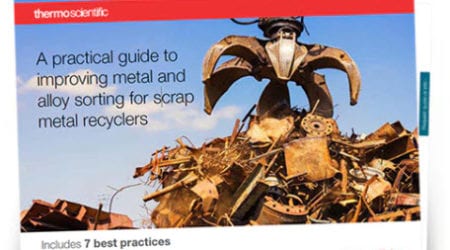 Laser Induced Breakdown Spectroscopy (LIBS) is an analytical technique that utilizes a highly focused laser that ablates the surface of a material in order to determine its chemical composition. LIBS has proven to be an important technology for Quality Control (QC) and Positive Material Identification (PMI) in material verification programs, especially for the iron and steel industry.
Laser Induced Breakdown Spectroscopy (LIBS) is an analytical technique that utilizes a highly focused laser that ablates the surface of a material in order to determine its chemical composition. LIBS has proven to be an important technology for Quality Control (QC) and Positive Material Identification (PMI) in material verification programs, especially for the iron and steel industry.
Most handheld LIBS analyzers utilize a pulsed laser with a wavelength of 1064nm. Short pulses (nanoseconds) of high energy produce enough power per unit of area to ablate a small amount of material (about a nanogram) and produce a plasma at the sample surface.
The light from the plasma is polychromatic (white light), which means it contains multiple different wavelengths. This white light is split into its component wavelengths by the diffraction grating, much the same way that white light is split into a rainbow of individual colors passing through a prism. Different elements emit specific wavelengths of light, and the intensity of that light is directly proportional to the concentration of element present.
The spectrometer measures how many photons of light are emitted at specific wavelengths and produces a spectrum of the sample. The peaks that are representative of the elements of interest are measured and produce a result to indicate concentration.
Every spectrometer used to measure the separate wavelength lines for each element must be highly stable in terms in mechanical dimensions. Given that the iron spectrum has several thousand closely spaced emission lines, the need for maintaining each element measuring window at the exact, absolute wavelength range is critical to avoiding interference from nearby lines that would otherwise drift into the analytical window — as the signal for the desired line drifts out of the window. This occurs if one does not have rock solid dimensional stability.
The material used to mount the spectrometer changes dimension ever so slightly with temperature. This causes errors in the readings.
Most handheld LIBS analyzers utilize Invar-36 as the spectrometer mount. Invar is a 36% nickel-iron alloy which has the lowest thermal expansion among all metals and alloys in the range from room temperature up to approximately 230°C (source: AZO Materials).
The Invar-36 mount has one of the lowest coefficients of expansion with temperature of most any metal. The entire spectrometer environment should also be temperature controlled to avoid swings in temperature that, however slight the expansion may be, would cause errors in the readings.
Most, if not all, suppliers use heat sinks to absorb temperature swings from the outside environment. The more mass the heat sink has the more it absorbs the temperature changes. To be more convenient, one could design with smaller sizes and less mass in the heat sinks. However, that usually compromises performance relative to a more robust design.
Users who are aware of these factors will almost always invest first and foremost based on performance because lives could depend on the results. When alloy analysis is done for the aerospace, automotive, oil and gas, and construction industries, mission-critical verification is not just a catch phrase … it is exactly what it implies!
Further recommended reading:
- Webinar: Why is Analyzing Carbon Important?
- ebook, LIBS Technology for Non-Scientists
- Additional Resources:
- Download our free eBook: A Practical Guide to Improving Steel Manufacturing Processes and Production Methods
- Visit our center for Improving Steel Manufacturing Processes and Production








Leave a Reply